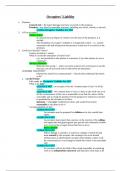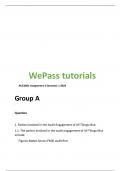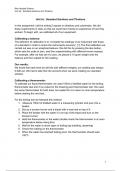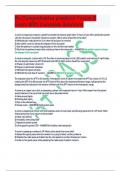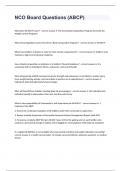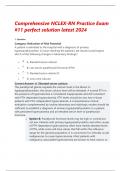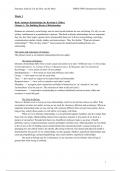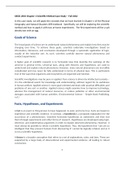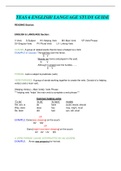1. Premises:
General rule = the injury/damage must have occurred on the premises.
Premises = any fixed or moveable structure, including any vessel, vehicle, or aircraft.
s.1(3)(a) Occupiers’ Liability Act 1957
2. Is D an occupier?
Wheat v Lacon –
If a person has any degree of control over the state of the premises, it is
enough.
The foundation of occupier’s liability is occupational control – i.e., control
associated with and arising from the presence in and use of or activity in the
premises.
3. Lawful or Unlawful Visitor?
Express invitation = easiest.
What if exceed the limitations of lawful visit?
e.g., not permitted to take photos in a museum, if you take photos are you a
trespasser?
Harvey v Plymouth –
Reiterates the saying “…when you invite a person into your house to use the
staircase, you do not invite him to slide down the bannisters.”
CONFIRM THIS POINT:
Objectively what D has communicated – what do they understand the limits
to be?
a. Lawful Visitor:
Falls under the Occupiers’ Liability Act 1957
What is the duty?
s.2(1) OLA 1957 – an occupier owes the “common duty of care” to all his
visitors.
s.2(2) OLA 1957 – the common duty of care is a duty to take such care as in
all the circumstances of the case is reasonable to see that the visitor will be
reasonably safe in using the premises for the purpose for which he is invited
or permitted by the occupier to be there.
Question = what more could D have done, and would it have been
reasonable to ask them to do it?
Varying standards of duty:
s.2(3)(a) OLA 1957 –
An occupier must be prepared for children to be less careful than
adults.
s.2(3)(b) OLA 1957 –
An occupier must expect that a person, in the exercise of his calling,
will appreciate and guard against any special risks ordinarily incident
to it, so far as the occupier leaves him free to do so.
Roles v Nathan
s.2(4)(a) OLA 1957 –
Where damage is caused to a visitor by a danger of which he had
been warned by the occupier, the warning is not to be treated
without more as absolving the occupier from liability, unless in all
the circumstances it was enough to enable the visitor to be reasonably
safe.
s.2(4)(b) OLA 1957 –
An occupier will not be liable if they acted reasonably in entrusting
work to an independent contractor and had taken such steps as he
, reasonably ought in order to satisfy himself that the contractor was
competent and that the work had been properly done.
Ferguson v Welsh
Smith LJ in Everett v Comojo –
“The common duty of care is an extremely flexible concept,
adaptable to the very wide range of circumstances to which it has to
be applied… It can give rise to vicarious liability for the actions of
an employee of the occupier who, for example, might have
created a temporary tripping or slipping hazard.”
b. Unlawful Visitor:
Falls under the Occupiers’ Liability Act 1984
s.1(3) OLA 1984 – an occupier only owes a duty if:
(a) he is aware of the danger or has reasonable grounds to believe that it
exists,
(b) he knows or has reasonable grounds to believe that the other is in the
vicinity of the danger concerned or that he may come into the vicinity of the
danger, and
(c) the risk is one against which, in all the circumstances of the case, he may
reasonably be expected to offer the other some protection.
Tomlinson v Congleton BC – not owed a duty with regard to an
obvious risk.
What is the duty?
s.1(4) OLA 1984 – the duty is to take such care as is reasonable in all the
circumstances of the case to see that he does not suffer injury on the premises
by reason of the danger concerned.
Tomlinson v Congleton BC – this depends upon assessing not only
the likelihood that someone may be injured and the seriousness of the
injury which may occur, but also the social value of the activity
which gives rise to the risk and the cost of preventative measures.
These factors have to be balanced against each other.
Must be “due to the state of the premises” – s.1(1)(a) OLA 1984
Tomlinson v Congleton –
C went into lake in disused quarry and from a standing position in
shallow water dived and struck his head on the bottom, breaking his
neck. Swimming in the lake was prohibited and Ds displayed
prominent notices reading “dangerous: no swimming”.
Any risk of the plaintiff suffering injury had arisen not from any
danger due to the state of the premises but from P’s own
misjudgement in attempting to dive in too shallow water.
There was nothing special about the configuration of the lake
– there were no hidden dangers.
Lord Hoffmann: “otherwise any premises can be said to be
dangerous to someone who chooses to use them for some
dangerous activity.”
BUT – the standard of care required under OLA 1984 can depend on the age
and capacity of the trespasser.
Keown v Coventry NHS Trust –
C, a 11-year-old trespasser fell while playing on a fire
escape.
Longmore LJ –
Whether a danger is attributable to the state of the
premises or to the activity carried out by C is “a
question of fact and degree” that depends on whether
C has the capacity to perceive the danger.

